First off, an introduction. For anyone that doesn't know: I'm the programmer, designer and artist on this project. The game was a labor love from a core team of four guys, and it was released on December 29, 2016.
Disclaimer: These are my personal recollections of the process, not the collective experience of the team. First, I'm going to go through a little bit of the earlier history, and then move into the actual development process of the game. I love all the guys who worked on Kalaban, and without these fellow developers, none of this would've happened.
And what's most remarkable: some of the people working on the game still haven't seen each other face-to-face. The project was created with the magic of Internet, utilizing Skype and a number of digital storage services such as Google Drive and Dropbox.
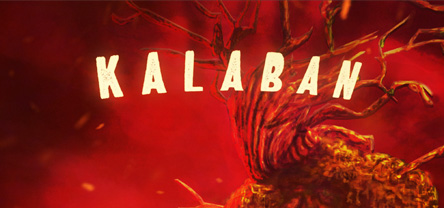
Rayhouse Productions was founded in November 2013. We were a bunch of indie filmmakers, who had previously worked together on numerous short film projects. In the beginning, we had this idea of doing commercials, content design and graphic design as client work. We were open for new ventures, with the possibilities of this newly formed company.
This was me, in April 2014, thinking that I'm going to change the world with my upcoming indie game. My first indie game in seven years. As a teenager we had done 3D game projects, but none of them ever got finished. And we made several smaller 2D games before that. I have been doing indie games since I was 10. It's always been my passion, ever since I saw the first computer games as a kid.
Not going into too much detail with my personal history, but I was not in a good place mentally during the spring of 2014. I had grown totally frustrated with the world of freelance work, and I was ready to shift gears from moving pictures into the interactive medium of games. It seemed like a real golden land of opportunities at that time.

I had moved to Tampere at the end of 2013, after graduating from my previous school at Pori. I had done a Bachelor's degree on audiovisual studies, and I was basically unemployed at the time, even though we had formed Rayhouse. I was still dreaming about my film projects, and I even out a draft of my feature-length script Warplay into the Finnish Film Foundation. The FFF is the biggest funder of scripts in Finland, unfortunately I got a negative response to my application.
But they good folk at Film Foundation pointed me to a screenwriting program here in Tampere, to which I applied, and got in. It was a Master's Degree in international screenwriting, and just what I was looking for. At the same time, my whole mental picture and mindset was changing. I had previously been an old-school 2D graphics guy, and had just started learning Autodesk 3ds Max. Getting into 3D graphics proved to be a great decision for me. Without that acquired knowledge, the pre-rendered characters and backgrounds in Kalaban would not have been possible, nor any of the stuff done since.

Pasila, Helsinki in 2013.
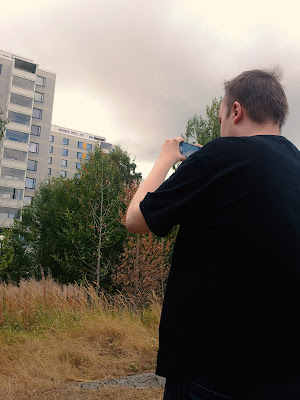
Me and Juha Peltomäki, one of the guys at Rayhouse Productions, attended the Assembly Summer computer festival. When there was no special activity at the festival site, we took a walk to the city and park nearby, and explored the locations.
In April 2014, I started my first independent game project, after taking a long break from the indie scene. I had previously worked at a bigger game company in Pori, and I got laid off from there in early 2013. That was roughly at the same time as I graduated from Bachelor's degree studies. So, I kind of had this year of searching myself. I applied for numerous jobs in Pori, ranging from graphic design to audiovisual production, but I got rejected from all of them.
After spending the whole spring and summer unemployed, at this crummy apartment in Pori, I realized things had to change. I had started developing this board game called Neurotron with my buddy back from school, Vesa-Pekka Koivisto, who has also worked at that game company in Pori. We were trying to raise money through a crowdfunding campaign for the board game during the fall of 2013. When that fell through, I kinda felt that it was time for me to search other job possibilities at Tampere.
This was me in March 2015, during my Master's Degree studies:

That's me on the sunny and windy streets of Manchester. We made this trip to Britain during the studies, where we discussed our feature-length drafts and pitched a new concept for a TV series to our teacher.
My studies at Tampere taught me a lot during the course of one year. I had always been interested in screenwriting for games and movies, but had never done them professionally. During my time at Pori I had written a few feature-length scripts, but they were all godawful. I was really eager to learn more, and decided to put my ego aside while learning to get better at my craft.
Those Master's Degree studies also taught me a valuable question, which you must be able to answer about your script: " What's the story? "

The view outside the window, taken from the balcony of our flat during the trip.

At the same time, our development team had begun the actual work with Kalaban. The concept was conceived during a car trip with me and Tuukka Kuusisto, our creative director, in November 2014. Me and a couple of buddies at Rayhouse were visiting Tuukka, and we got talking about game design.
I had already done a few early games in 2014, and Tuukka had this idea of a story-oriented survival game, kinda like a mix of Don't Starve, Notrium and Driftmoon. The idea sounded really interesting to me, and first we were going to base it on a topdown shooter prototype I had done called Skipocalypse. That game had anthropomorphic animals as main characters, and it was more tongue-in-cheek than what Kalaban became.
Through a couple of twists and turns we started working on the top-down action-adventure game, that we all know today. We recruited Eetu Suoranta as our musician and sound effects guy, who was already a familiar collaborator to our short film projects. We also got Vesa-Pekka Koivisto, the friend who had helped me out with Neurotron board game, to do the character design and player animations. Both of them were my school buddies, and both of them had worked at the same bigger game company in Pori.
In January 2015, the vision for Kalaban had formed into: "A horror-themed version of DreamWeb, set in Finland during the 1990s, with inspiration from Sanitarium, with a little bit of Hotline Miami style action thrown into the mix. And all of this done from a slanted top-down angle, to best simulate a 3D game world".

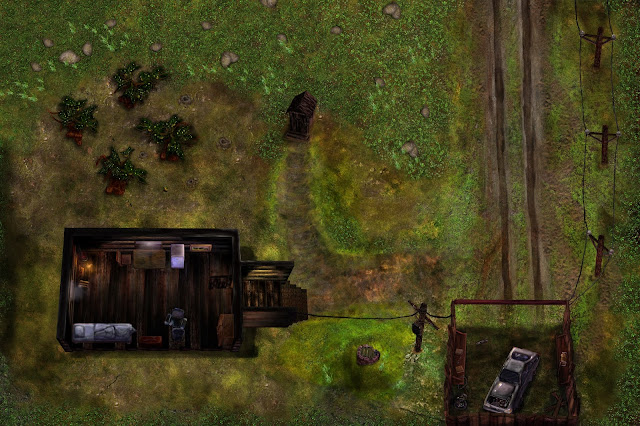
The picture above is the very first sketch for a level in Kalaban.
The one below that is a later rework of the same scene, when we had set upon this more realistic design for the game world. Kalaban was never meant to be photorealistic, although it's set in real world inspired locations. Through the development we rode this line between comic book horror style, and a more believable design.
The game was developed completely with Clickteam's Fusion 2.5 engine and tools. To those who aren't familiar with that software, maybe you've heard of their earlier efforts: Klik&Play and The Games Factory. Yes, Kalaban is actually a "Klik&Play game". This is due to the fact that I'm not actually a professional programmer. I've always been more of a graphics and design type of guy, who just had to get into coding as a necessity. Since the release of Kalaban I have been using Unity constantly, but at the time I had to make some consents. It was either going to be art and design, or programming and learning a new engine.
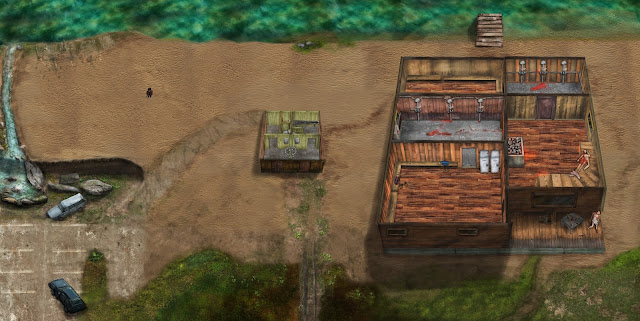
Clickteam's software can be described kindly as a "visual programming tool". A lot of things have to be done differently, than on regular programming tools, but most of the same rules apply. You have to learn a little bit of math, and know something about algebra. And always, plan ahead and think about what you're doing. The other part of Clickteam's software is like working with obsolete game making tools, such as Ken Silverman's iconic Build engine.
I grew up loving Build as a kid, and I did a huge amount of maps with it. Me and my friends basically did mods to Duke Nukem 3D, where we would mess around with the configures and setting of the game, resulting in different effects inside the game. To me, working with these kind of rough and outdated tools has always been an exciting challenge. It's great to see what you can really do with them, and take the software to its absolute limits. A lot of Kalaban's development was like that.
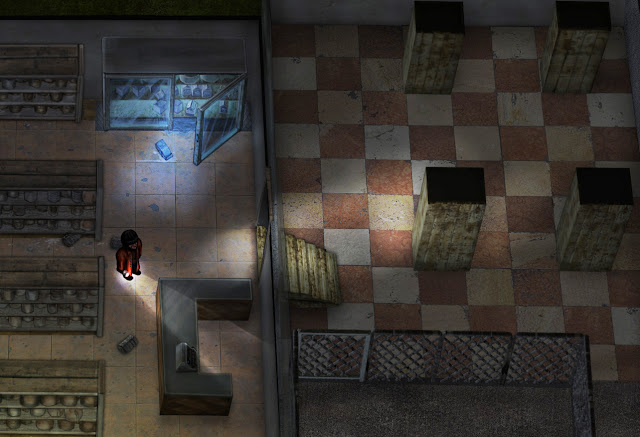
By the way, what happened to that first indie game? If Kalaban was started in January 2015, then what was the first game I worked on during the spring of 2014?
Actually, it was a digital version of the Neurotron board game, visioned as a cheeky retro role-playing game. It was totally my personal prep school for getting back into game development.
 Neurotron, which was our entry to Assembly Summer festival's gamedev competition.
Neurotron, which was our entry to Assembly Summer festival's gamedev competition.
As I mentioned in the beginning, we had already developed indie games as teenagers. Most of those projects were 3D first person games, which simply were impossible to pull off. There's too much story related to those projects for me to cover in a single post, so I'll have to revisit those some other day. But those earlier projects had provided me with enough insight, that I knew I had to do things differently this time around.
I figured that, first of all: doing 3D games as a single developer would be impossible. Especially combined to the type of games, that I would be interested in creating. And that was really important for me, that I didn't just go on and create some Angry Birds or Bejeweled




































